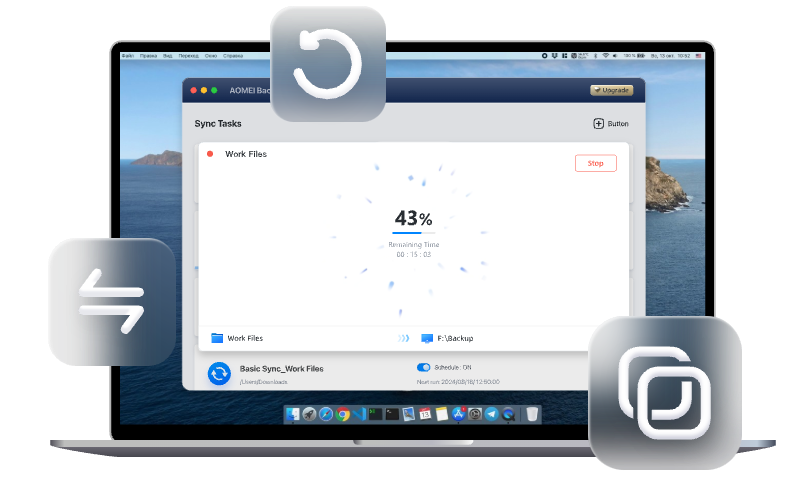Methods to Mac Sync Time and File Synchronization Guide
We delve into the importance of keeping your Mac sync time, ensuring accuracy and seamless performance across all your applications and services. We also explore an awesome way for Mac file synchronization with detailed step-by-step instructions to guide you through the process.
Introduction
In today's digital age, time accuracy is paramount. Whether you're scheduling meetings, running software updates, or ensuring precise data logging, having the correct time on your Mac is essential. This guide will walk you through various methods to ensure your Mac's clock is always synchronized, providing you with the accuracy and reliability you need. Except for this, we will also provide you with a great way to sync your files on Mac to save your time effortlessly.
Reasons Why Date and Time Won't Automatically Sync
There are several reasons why date and time might not automatically sync on a Mac:
⚡Server Issues: The time server your Mac connects to might be experiencing issues. Try changing the time server in "System Preferences" > "Date & Time" > "Set date and time automatically" and selecting a different time server from the list.
⚡Outdated macOS: An outdated operating system can cause synchronization issues. Make sure your Mac is running the latest version of macOS by checking for updates in the "System Preferences" > "Software Update.
⚡Internet Connection Issues: Automatic synchronization of date and time requires a stable internet connection. If your Mac is not connected to the internet or has a weak connection, it may not be able to sync.
⚡Incorrect Time Zone Settings: If your time zone is not set correctly, the automatic date and time settings may not work properly. Ensure that the time zone is set to the correct region for accurate synchronization.
⚡Disabled Automatic Settings: The option to set date and time automatically may be turned off. Go to "System Preferences" > "Date & Time" and make sure the "Set date and time automatically" option is checked.
By addressing these potential issues, you can usually resolve problems with automatic date and time synchronization on a Mac.
Top Solutions for Mac Sync Time
Method 1: Automatically Set Date and Time in System Preferences
If you're unfamiliar with macOS, you might not know where to find the date and time settings. Adjusting Mac OS time sync settings in the System Preferences app can often resolve issues. Simply ensure the "Set date and time automatically" option is enabled. Here's how:
1. Open the Apple menu and select System Preferences.
2. Navigate to General > Date & Time. Enter your administrator password if prompted.
3. Check the box for Set date and time automatically.
Method 2: Change the Time Server to Sync the Date and Time
When you make Mac time synchronization automatically, it typically uses Apple's servers for accurate information. However, server issues or miscommunication can sometimes cause your Mac to show the wrong date and time.
To fix this, you can switch to a different server to see if it resolves the issue. Here's how to do it:
1. Open System Settings and go to General > Date & Time.
2. Make sure the "Set date and time automatically" option is enabled, then click the "Set" button next to Source.
3. Enter your admin password or use Touch ID to unlock the settings.
4. Change the time server in the Date & Time settings.
Here are some of the best public time servers you can use:
🚩time.google.com
🚩time.facebook.com
🚩time.windows.com
🚩time.cloudflare.com
You can try different servers to see which one works best for you. To reset to the default settings, go to the Date & Time settings and select the Default option under Set.
Method 3: Set the Right Time Zone
Using Location Services is an easy and effective way to ensure your Mac automatically sets the correct time zone. With this feature enabled, macOS will adjust your date and time settings based on your current location. It also updates automatically for seasonal changes, like daylight saving time.
Here's how to set your date and time by location:
- Open System Settings and go to General > Date & Time.
- Enable the option to "Set time zone automatically using your current location."
Bonus: Sync Your Files and Documents on the Mac OS
Now that you have time synchronization fixed on your Mac, it's just as important to sync your data files because it helps your workflow. AOMEI Backupper Mac provides an excellent solution for syncing your data. It features an intuitive interface and powerful tools, making data protection straightforward. With its reliable and efficient syncing capabilities, AOMEI Backupper ensures your data is always secure and accessible.

- Sync All Your Mac Files: Ensure comprehensive protection by syncing any files on your Mac.
- Versatile Sync Options: Utilize Basic Sync, Mirror Sync, and Two-Way Sync for diverse synchronization needs.
- Multiple Storage Destinations: Sync to local drives, cloud storage, NAS devices, external hard drives, USB flash drives, SD cards, and more.
- Fast and Secure: Experience high-speed synchronization with advanced technology and secure encryption processes.
Step 1: Download and install AOMEI Backupper Mac software on your Mac. Open the application and click "New Task" to begin.
Step 2: Choose a sync type. Basic Sync is usually sufficient for file transfers.
Basic Sync: Copies files from one location to another without deleting the original files at the destination.
Mirror Sync: Creates an exact replica of the source at the destination, deleting any original files at the destination that don't match the source.
Two-Way Sync: Keeps files in both the source and destination locations updated, reflecting changes made in either location to ensure both places have identical files.
Step 3: Select the source and destination for your sync.
Step 4: Adjust the schedule and options as needed.
You can set synchronization frequency to once, hourly, daily, weekly, or monthly, and specify start times and post-sync actions like hibernation or shutdown.
In Options, customize settings such as File Inclusion, File Exclusion, and Folder Exclusion. from the sync process.
Step 5: Once everything is set, click "Sync" and wait for the process to finish.
FAQs About Mac Sync Time
Q 1: Why is my Mac's time not syncing automatically?
A 1: This can be due to incorrect settings in Date & Time, lack of internet connection, or issues with the NTP server. Check your settings and ensure your Mac is connected to the internet.
Q 2: How often does macOS sync time automatically?
A 2: macOS typically syncs time periodically based on your settings and network conditions. You can manually trigger a sync if needed using the Terminal.
Q 3: How can I ensure my Mac's time is always accurate?
A 3: Regularly check your sync settings, use reliable NTP servers, and consider third-party applications for more frequent synchronization.
Tips for Maintaining Accurate Time on Your Mac
Regularly Monitor Time Settings: Check your Mac's time settings periodically to ensure accuracy.
Use Reliable NTP Servers: Sync with reputable NTP servers to minimize the risk of time drift.
Keep Your Mac Updated: Regular software updates can resolve potential issues with time synchronization.
Conclusion
Keeping your Mac's time synchronized is essential for data integrity, scheduling, and overall functionality. By leveraging the methods above, you can ensure your Mac's clock remains accurate and reliable. This guide provides all the necessary steps and solutions to help you master Mac sync time. And also, keeping your files synchronized is also important, try AOMEI Backupper Mac to help you achieve this without effort.

